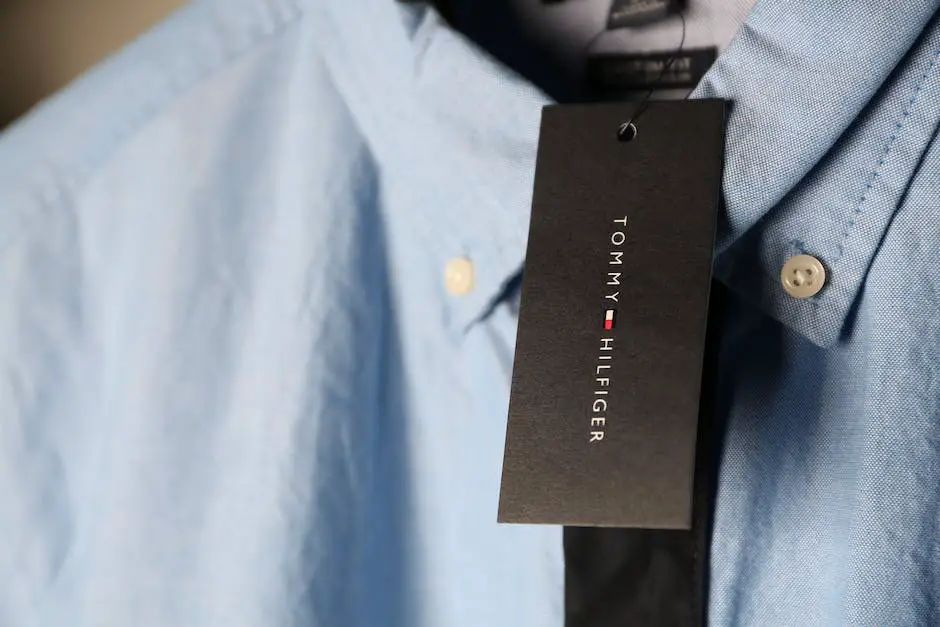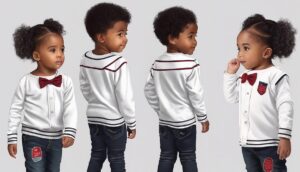Are you occasionally baffled by the children’s clothing sizes, especially when it comes to deciphering the difference between 4t and 4? You’re certainly not alone. In this enriching exploration, we delve into the subtleties surrounding these two sizes often used in toddler clothing. Through this journey, we’ll disentangle the meaning of 4t, demystify the numerical value of 4, highlight the practical differences between the two, and furnish you with guidelines on how to choose the right size for your child. Along the way, you’ll also gain valuable shopping tips that can enhance your clothing selection experience for your little ones.
Understanding 4t
A Parent’s Guide: Understanding the ‘4T’ in Children’s Clothing Sizes!
Ever found yourself shoulder-deep in adorable masterpieces of pint-sized fashion, only to reel a bit about the sizing? Suddenly, mysterious letters and numbers start popping up into the mix – 4T to start. What does it mean when you find 4T on a dress tag for your toddler? Today, we’re going to shed some light on the often baffling world of children’s apparel sizing. Buckle up!
‘4T’: the size that toddler dreams are made of!
The term ‘4T’, prevalent in children’s clothing, stands for ‘Toddler’. Put shortly, the ‘T’ is for Toddler, and the numerical value signifies the average age of a child who would fit the noted sized apparel. So, a 4T size label means the clothing item is typically suitable for a four-year-old toddler.
Why is 4T distinct from the simple number ‘4’?
Some might wonder – why can’t we have 4, 5, 6, for sizings instead of 4T, 5T, and so on? Well, the addition of the ‘T’ factor actually makes a world of difference.
The ‘4T’ size considers toddlers who are still in diapers and their unique body shape. Clothing pieces with these labels come with some extra room for accommodating this aspect. On the other hand, the ‘4’ size sans ‘T’ usually mirrors the physique of older, potty-trained kids, with lesser roundness around the belly area.
Does ‘4T’ imply the same size across all brands?
In an ideal world, yes. But unfortunately, we don’t live in such a utopia. Just as with women’s clothing, even toddlers’ apparel brands have their interpretation of sizes. While ‘4T’ generally stands to cater to a four-year-old, the measurements concerning waist, height, and weight could slightly vary from one brand to another. Hence, always skim through the brand’s size chart while shopping.
Tips for buying ‘4T’ clothing
- Consider your child’s growth: Toddlers grow significantly across different phases. So, don’t rely strictly on age-based sizing. Observe their growth pattern before settling on a size.
- Account for shrinkage: Not all clothing materials handle laundry the same way. Cotton, for instance, is prone to shrinking. So, pre-empt this before buying.
- Shop according to the season: Flexibility is vital when it comes to children’s wear. If it’s summer, only focus on breezy, comfortable clothes rather than thick, layered ones because they are available in your child’s size.
- Give importance to comfort: While style matters, a child’s comfort is paramount. Make sure the clothes aren’t tight and restrictive, causing discomfort.
So now, the ‘4T’ mystery stands revealed. Understanding the nitty-gritty of toddler clothing sizes can seem like a herculean task. But armed with the right information—and naturally, that innate parental intuition—we can turn our little ones into the trendsetters they were born to be!

Understanding 4
Sure, let’s delve right into the clarification of a size ‘4’ in the world of children’s clothing.
Narrowing down to a ‘4’, it indicates clothing suitable for a child around four years of age. Here is the important thing to remember: if you’re shopping for a toddler or a small child, expect to find clothing labeled ‘4’ to be slightly bigger than the ‘4T’ size. Why, you wonder? It is designed that way keeping in mind that children of that age might have outgrown toddler sizes, and they’re also presumably out of diapers, which allows for a little more room in the clothing.
One more integral aspect of the number ‘4’ in clothing sizes is the design. In comparison to ‘4T’ sizes, ‘4’ sized clothing often has a different design more suited for a slightly older child. These differences may include features like buttoned shirts or belts which are absent in ‘4T’ sizes to make dressing easier for little ones. It’s like a small step towards dressing ‘big kid’ style.
Keep this next tip in mind when you’re out shopping for your little one. While the number ‘4’ might roughly match a four-year-old’s age, it doesn’t directly translate to your child’s height or weight. Every child grows at their own pace, and you might find yourself needing a size up or down to best fit your child.
That’s where size charts and labels step in. Different brands may size their clothing differently, so it’s always a good practice to check their specific size chart. Measurements usually include chest, waist and height, to help you understand if a ‘4’ size would be the best fit for your child.
Furthermore, given the diversity of body types among children, clothing labeled ‘4’ may come in sub-sizes such as ‘4S’ for small, ‘4R’ for regular, and ‘4H’ for husky or hefty. These sub-sizes help tailor the fit for children who may be shorter or rounder than the average size ‘4’ child.
In conclusion, when it comes to a size ‘4’ in children’s clothing, it’s all about understanding the meaning behind the tag, considering your child’s growth and comfort, and always checking the size charts before making a purchase. And remember, fellow parents, our precious little ones grow up so fast, so enjoy each moment of their journey from ‘4T’ to ‘4’ clothing and beyond! Happy shopping!

The Practical Differences
All About 4’s: The Mystery Behind Children’s Clothing Sizes
When diving into the sea of clothing choices for little ones, many often wonder about the difference between sizes 4 and 4T. Having a quick run-down is a lifesaver, especially for first-time parents or those who just aren’t too familiar with children’s clothing.
So, what does a size ‘4’ signify in children’s clothing? The ‘4’ essentially stands for the average four-year-old child. This size is generally catered towards children who are in pre-school, transitioning from the toddler years to a bigger kid stage. However, it’s essential to remember that size labels aren’t directly proportionate to your child’s age, height, or weight. Like adults, children’s growth rates and body shapes differ.
This is where 4T and the size ‘4’ start to diverge. While 4T is more accommodating for diapers and a toddler’s rounder body type, size ‘4’ is typically designed for older children who may be more proportionate or leaner. The design of size ‘4’ clothing often mirrors miniature adult clothing, with less room for diapers and differing cuts and hems!
Now let’s face it, everyone – children and adults alike – come in all shapes and sizes. Isn’t it a relief then that children’s clothing also include sub-sizes like ‘4S’, ‘4R’, and ‘4H’? These options were created with different body types in mind, providing narrower or wider fits to accommodate all children. ‘4S’ often relates to a more slim fit, while ‘4R’ usually fits most children, and ‘4H’ caters to those who could use a bit of extra room.
However, wouldn’t it be so wonderful if every brand followed the same sizing chart? Unfortunately, this isn’t always the case, and hence it is crucial to always check size charts and labels for accurate fit. You can usually find these size charts on a brand’s official website or even sewn into the clothes themselves. They can help you more accurately determine which size will be the most comfortable and presentable for your child.
So, why does understanding all this matter? As a parent, you want your child to feel confident and comfortable, and wearing well-fitting clothes can be a major contributor to this. Indeed, the journey of finding the perfect outfit for your child can be quite an adventure. Yet, this adventure first begins at understanding how sizes work, leading to more efficient shopping experiences and ideally fewer returns or exchanges.
In conclusion, whether your little one is running around in a 4T onesie or strutting their stuff in a ‘size 4’ dress, remember that sizing goes beyond just a tag on a piece of clothing. It’s an integral aspect to consider when embarking on your child shopping adventures! So parents, may your journeys always lead you to the perfect outfits for your little ones.

Choosing the Right Size for Your Child
At times, even some of the most experienced parents or grandparents can feel like they’re trying to solve a riddle when trying to figure out the appropriate size for their child’s clothing. After understanding the 4T sizing, let’s move on to the mysterious 4 size and delve into how to determine when is the right time to make that transition.
A size ‘4’ in kid’s clothing is primarily built for children who have outgrown the toddler stage. Often, this size caters to children between the ages of four and five. The main point that sets it apart from 4T is that it’s meant for older kids who might be a bit more proportionate or even slim in stature.
While the 4T size is customized for toddler’s unique body shapes, with room for diapers and allowance for their rounder bellies, the size ‘4’ is cut more straight and narrow, reflecting the changes in a child’s body as they grow. This clear-cut design difference is essential to note when you’re deciding between a 4T and a 4 for your kid.
Despite these guidelines, it’s crucial to remember that a size ‘4’ isn’t a standard measurement that directly corresponds to your child’s weight or height. It can be slightly confusing since one might assume that size ‘4’ is for 4-year-olds, but this isn’t always the case. We need to remember that each kid grows at a different rate, so it’s important to regularly check size charts and labels for the most accurate fit.
Designers also offer sub-sizes like ‘4S’ for the petite, ‘4R’ for the regular, and ‘4H’ for the slightly heavier kids. These further enhance a parent’s ability to personalize their child’s clothes, ensuring a more accurate fit.
Clothes fitting well is more than just about appearances; it plays an important role in a child’s sense of comfort and confidence. An ill-fitting garment can make a child feel self-conscious or even result in discomfort. Hence, understanding the nuances of sizing can help enhance your child’s confidence and comfort.
Knowing your way around sizes provides more efficiency during shopping – online or offline. This understanding drastically reduces the need for returns and exchanges, making shopping a more pleasant experience all around. Plus, you can’t deny the joy you feel when your child tries on their new outfit, and it fits as if it was tailor-made for them!
In conclusion, size transitioning from a 4T to a 4 depends on various factors such as your child’s body type, growth rate, and comfort. Never hesitate to use size charts and labels to ensure the most accurate fit. Remember, making the best choices for your child’s clothing is more a testament of love than just a task on a to-do list. Invest in understanding sizes as it’s a worthwhile investment in your child’s confidence and comfort.

Advice for Shopping for Sizes 4t and 4
After understanding what 4T and size 4 represent in children’s clothing and differentiating between the two, it’s time to delve deeper into other aspects that every parent should know when buying these sizes. This revolves around age ranges, transition considerations, design differences, and related topics.
Primarily, size 4 clothing is generally designed to fit children aged around four to five years old. However, every child grows at their own pace. Some might outgrow their clothes faster, while others might fit into the same size for a longer period. Hence, considering the child’s personal growth trajectory is crucial in determining when to transition from 4T to size 4.
A noticeable aspect about children’s fashion is that designs often change as sizes increase. While 4T clothes draw more towards baby clothes style with roomier designs for accommodating diapers, size 4 clothes begin to resemble mini versions of adult clothing. For example, you might find buttoned shirts, structured dresses, or jeans when shopping for size 4.
It’s also essential to note that size 4 is typically designed for slender, taller children due to the assumption that children in this age bracket have started eliminating baby fat and growing taller. Hence, if your child is bulkier or shorter, size 4 might not be the best fit even if they are in the right age range. Sub-sizes like 4S (Small), 4R (Regular), and 4H (Husky) come in handy in such instances, allowing parents to choose a better fitting size for their child’s unique body type.
The golden rule is not to rely solely on tags when shopping: rather, size charts and labels are the most reliable guides for getting an accurate fit – remember to check them. Many brands offer these charts, showing measurements for the waist, height, and sometimes even chest and hip sizes. Such detailed guidance can save time and make the shopping experience much more efficient, curtailing the need for returns or exchanges.
But the most important aspect to keep in mind is that comfortable and well-fitting clothes contribute significantly to a child’s confidence. Children in clothes that fit well and are comfortable to move in can engage in their activities without inhibition, from exploring their environment to socializing with others around them.
In essence, understanding the difference between 4T and Size 4 in children’s clothing is only part of the puzzle. Keeping considerations like the age range, design differences, the introduction of sub-sizes and the need to check size charts firmly in mind when shopping can lead to fewer returns, more efficient shopping experiences and most importantly, a happy, comfortable child.

Understanding the distinction between children’s clothing sizes can be a challenge, especially when it involves terms like 4t and 4. However, with the insights provided in this discussion, you are now equipped with the knowledge to navigate these complexities. From understanding what 4t and 4 mean, to differentiating between them, choosing the right size for your child, and even acquiring shopping tips, you are now prepared to make more informed decisions regarding your child’s wardrobe. Remember, the goal is to ensure your child’s comfort and happiness, so every insight gained is a stepping stone towards achieving that objective. Stay sharp, shop smart, and happy parenting!

As a mother of four very energetic children, Emilia knows how chaotic motherhood can be. She’s learned a lot of lessons along the journey so far and loves sharing the tips & tricks she’s picked up over the years with anybody else on the same life path.

